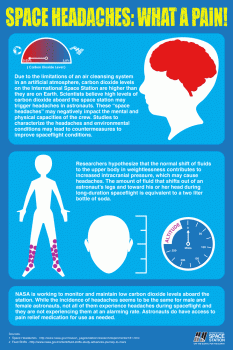ESA astronaut Andreas Mogensen has been in space for around six hours but already the science programme has started. While flying to the International Space Station he fill in questionnaires on any headaches he might experience.
Headaches can be a common astronaut complaint during spaceflight – especially during the first week. This is not surprising as an astronaut’s brain has a lot to cope with. The stress of launch, the disorientation of floating in weightlessness and blood that normally sinks towards your feet on Earth goes towards the head in space.
Preliminary studies into astronaut headaches have been done before but this is the first in-depth statistical investigation into headaches.
The Space Headaches experiment will improve our understanding of headaches which will help develop ways to alleviate their symptoms and improve the well-being of astronauts in orbit in and consequently their performance.
Experiment setup
24 astronauts should take part in the Space Headaches experiment with Andreas coming in halfway in the data-collection phase. Colleague astronauts already on the Space Station, NASA’s Kjell Lindgren and JAXA’s Kimiya Yui, are taking part in the study as well.
The questionnaire is two pages long and takes five minutes to fill in. It is multiple choice with ‘yes/no’ or ‘sliding scale’ answers.
During their first week of a mission, astronauts fill in the questionnaire every day and weekly afterwards until the end of their spaceflight. Andreas is the first astronaut to take part in the study on a short-duration mission so he will do the questionnaire each day until he returns to Earth on 11 September.
The questionnaire is a electronic document that is completed on a Station laptop. In the Soyuz spacecraft there is no laptop, so the researchers include paper printouts that Andreas will complete with a pencil. Once at the International Space Station he will photograph the first paper questionnaires and send the digital file to the researchers on Earth.



Discussion: one comment
Andreas,
My thougts and prayers are with you as you participate in the “headach study”!!
– Janet Sentral Illinois, USA.